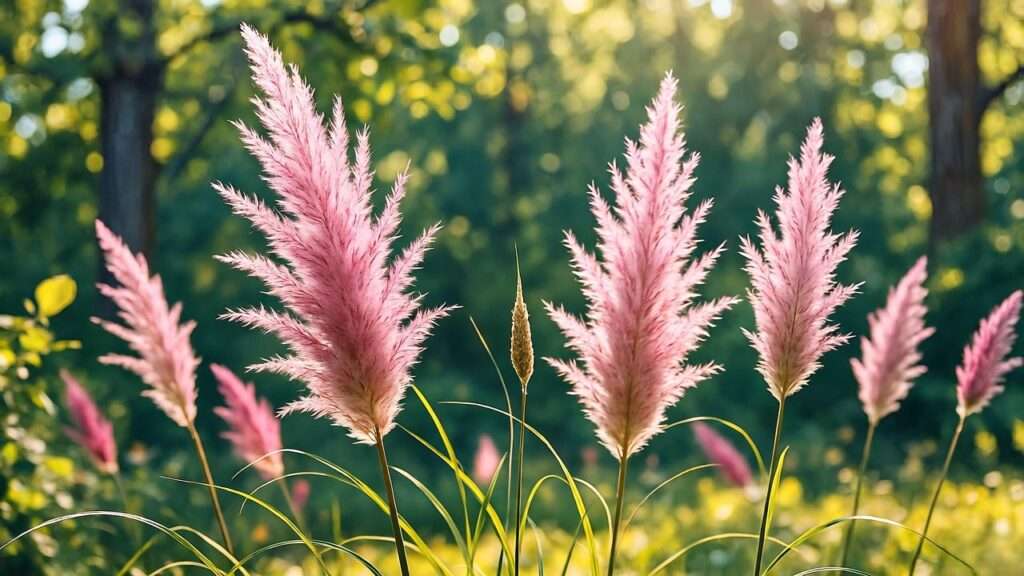Imagine transforming your garden into a breathtaking oasis with feathery, blush-pink plumes swaying in the breeze. Pink pampas grass plants (Cortaderia selloana ‘Rosea’) are the secret to achieving that dreamy, low-maintenance landscape that’s taking over Instagram and Pinterest. Whether you’re a beginner gardener or a seasoned green thumb, this vibrant ornamental grass delivers effortless elegance and year-round appeal. In this comprehensive guide, we’ll walk you through everything you need to know to grow and care for pink pampas grass plants, from planting tips to styling ideas for your garden and home. Get ready to create a stunning outdoor masterpiece! 🌿
This article draws on horticultural expertise, offering actionable advice to ensure your pink pampas grass thrives. We’ll cover ideal growing conditions, step-by-step care instructions, troubleshooting tips, and creative ways to incorporate this trendy plant into your landscape or decor. Let’s dive in and make your garden the envy of the neighborhood! 🏡
1. What Are Pink Pampas Grass Plants? 🌿
1.1. Overview of Pink Pampas Grass
Pink pampas grass, scientifically known as Cortaderia selloana ‘Rosea’, is a striking variety of ornamental grass native to South America. Its hallmark feature? Soft, feathery plumes in delicate shades of pink that tower atop sturdy, arching stalks, reaching heights of 6–10 feet. Unlike its white-plumed cousin, pink pampas grass adds a warm, romantic hue to gardens, making it a favorite for modern landscapes and boho-chic decor. This perennial grass is prized for its dramatic presence and ability to thrive in diverse climates (USDA zones 7–11).
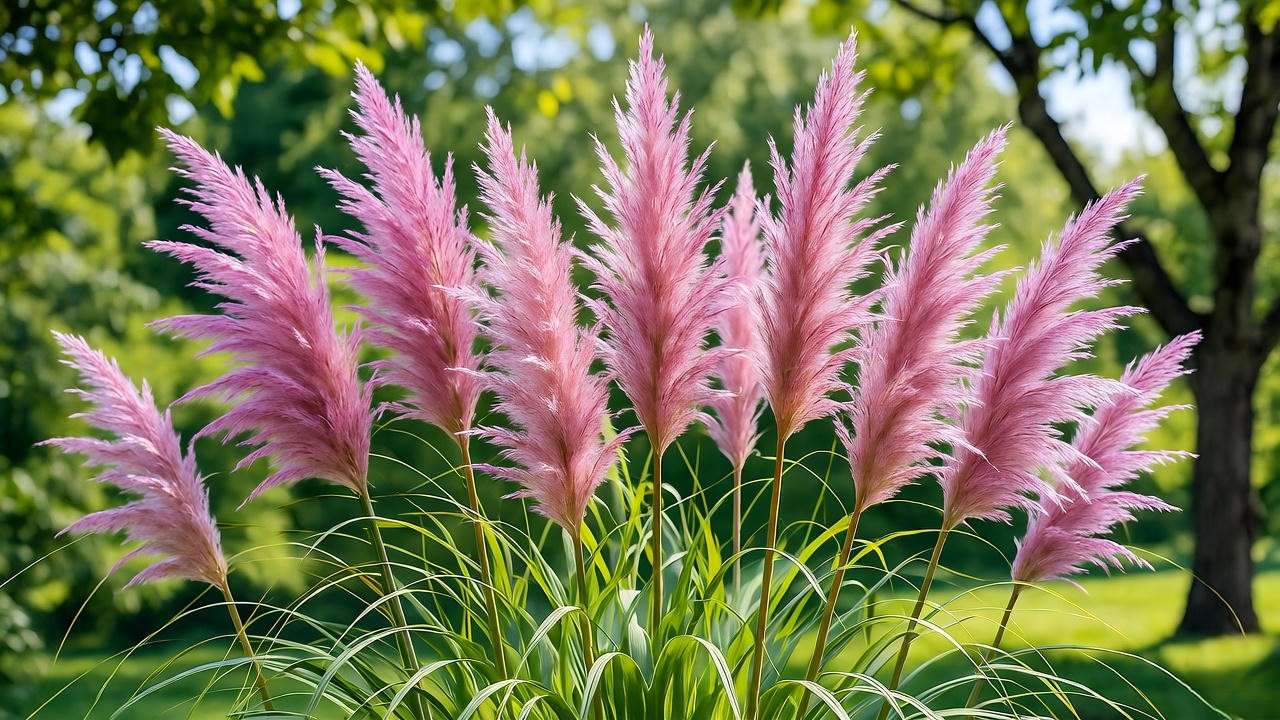
1.2. Benefits of Growing Pink Pampas Grass
Why choose pink pampas grass plants for your garden? Here’s why they’re a game-changer:
- Low-Maintenance: Once established, they require minimal care, perfect for busy gardeners.
- Drought-Tolerant: Ideal for water-wise landscapes, especially in dry regions.
- Versatile Design: Use as a privacy screen, border, or focal point in your garden.
- Eco-Friendly: Supports sustainable gardening with minimal resource needs.
- Decor Potential: Harvested plumes create stunning indoor arrangements for vases or wreaths.
Whether you’re aiming for a coastal vibe or a modern minimalist look, pink pampas grass delivers unmatched aesthetic appeal with minimal effort. 🌾
2. Understanding the Needs of Pink Pampas Grass Plants 🌞
2.1. Ideal Growing Conditions
To ensure your pink pampas grass plants flourish, provide the right environment:
- Climate: Thrives in USDA zones 7–11, tolerating temperatures as low as 0°F (-18°C) with proper care.
- Sunlight: Full sun (6–8 hours daily) is essential for vibrant plumes and robust growth.
- Soil: Prefers well-draining, loamy soil with a pH of 5.5–7.0. Sandy or clay soils work if amended with organic matter.
- Space: Allow 6–8 feet between plants to accommodate their mature spread.
2.2. Watering and Nutrient Needs
Pink pampas grass is relatively low-maintenance but has specific needs during establishment:
- Watering: Water deeply once a week during the first growing season. Once established, water sparingly, only during prolonged dry spells.
- Fertilization: Apply a balanced, slow-release fertilizer (e.g., 10-10-10) in early spring to boost growth. Avoid over-fertilizing, which can lead to weak stalks.
- Tip: Overwatering can cause root rot, so ensure proper drainage. Use a soil moisture meter for precision.
3. How to Plant Pink Pampas Grass 🌱
3.1. Choosing the Right Time to Plant
Timing is key for successful planting. Spring or early fall is ideal, allowing roots to establish before extreme heat or cold. In warmer climates (zones 9–11), fall planting works well, while spring is better in cooler regions (zones 7–8).
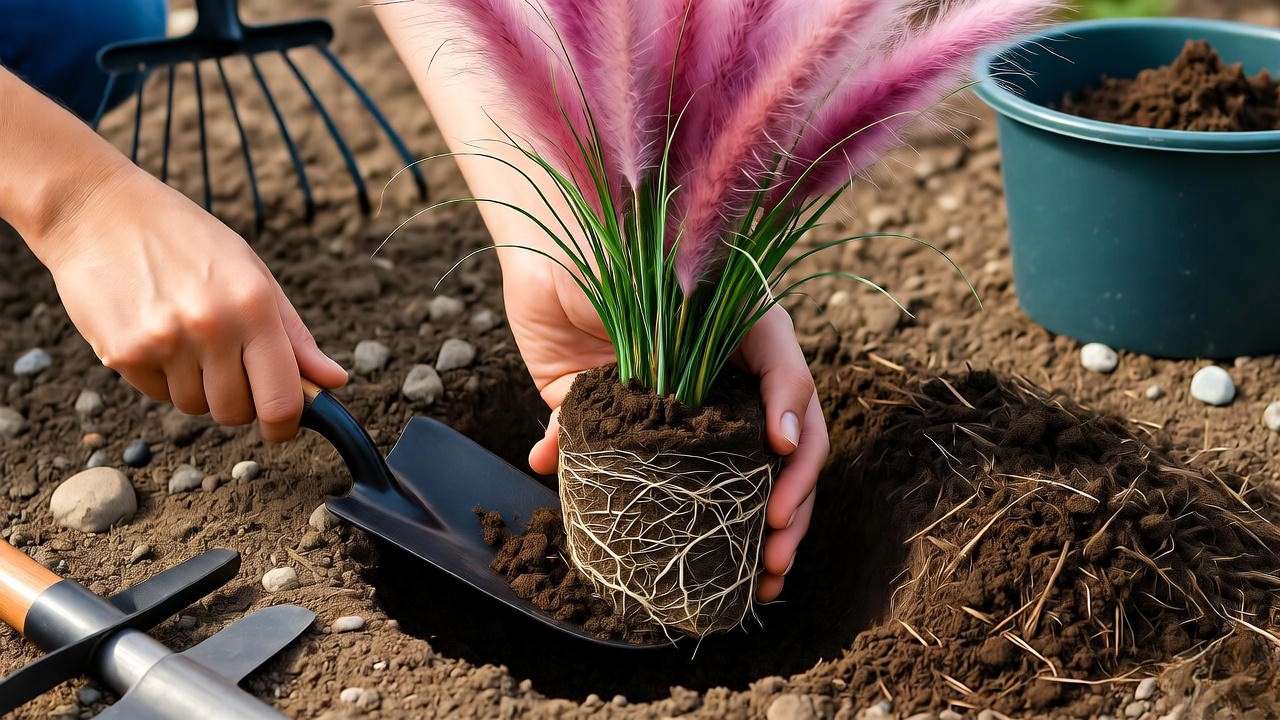
3.2. Step-by-Step Planting Guide
Follow these steps to plant pink pampas grass like a pro:
- Select Healthy Plants: Purchase from reputable nurseries or online suppliers. Look for vibrant green foliage and avoid wilted or yellowing plants.
- Prepare the Site: Clear weeds and amend soil with compost for better drainage.
- Dig the Hole: Make it twice as wide and as deep as the root ball.
- Plant: Place the root ball level with the soil surface, backfill, and tamp gently.
- Water: Soak thoroughly after planting to settle the soil.
- Mulch: Add a 2-inch layer of organic mulch (e.g., bark or straw) to retain moisture and deter weeds.
Pro Tip: Space plants 6–8 feet apart to prevent overcrowding and ensure good airflow, reducing disease risk.
3.3. Propagation Methods
You can propagate pink pampas grass via seeds or division:
- Seeds: Sow in spring, but germination is slow and inconsistent. Best for patient gardeners.
- Division: Divide mature clumps in early spring using a sharp spade. Replant divisions immediately and water well.
- Recommendation: Division is faster and more reliable for beginners, ensuring true-to-type pink plumes.
4. Caring for Pink Pampas Grass Plants 🌼
4.1. Watering and Maintenance Tips
Once established, pink pampas grass is a set-it-and-forget-it plant:
- Watering: Water mature plants only during extreme drought. Young plants need weekly watering for the first 3–6 months.
- Mulching: Refresh mulch annually to maintain soil health and suppress weeds.
- Seasonal Care: In spring, remove debris around the base to promote new growth. In fall, check for signs of stress before winter.
4.2. Pruning and Grooming
Pruning keeps pink pampas grass tidy and healthy:
- When to Prune: Late winter or early spring, before new growth begins.
- How to Prune: Wear gloves and long sleeves—blades are sharp! Cut back to 12–18 inches above ground using loppers or a hedge trimmer.
- Grooming: Remove dead or damaged fronds throughout the season to maintain appearance.
- Safety Tip: Dispose of cuttings carefully, as they can be a fire hazard when dry.
4.3. Pest and Disease Management
Pink pampas grass is relatively pest-resistant but watch for:
- Pests: Aphids or spider mites may appear in humid conditions. Use neem oil or insecticidal soap for organic control.
- Diseases: Fungal issues like root rot can occur in poorly drained soil. Ensure proper drainage and avoid overwatering.
- Signs of Stress: Yellowing leaves or stunted growth may indicate nutrient deficiency or water issues. Test soil and adjust care accordingly.
5. Designing with Pink Pampas Grass in Your Landscape 🏡
5.1. Landscaping Ideas for Pink Pampas Grass
Pink pampas grass plants elevate any garden design:
- Focal Point: Plant a single clump in a lawn for dramatic effect.
- Privacy Screen: Line them along a fence for a natural, colorful barrier.
- Border: Pair with low-growing plants like lavender or salvia for contrast.
- Coastal or Modern Gardens: Their soft texture complements minimalist or beachy aesthetics.
Companion Plants: Try Russian sage, coneflowers, or black-eyed Susans for a vibrant, harmonious look.
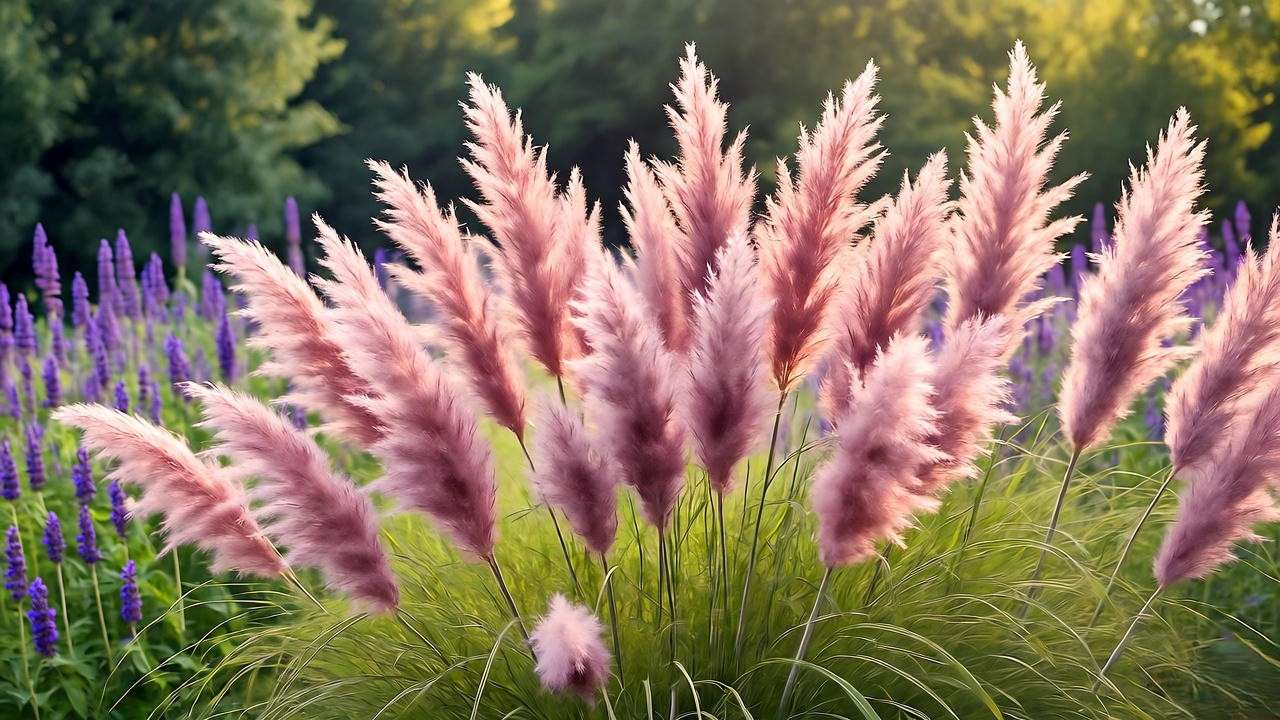
5.2. Incorporating Pink Pampas Grass in Home Decor
Harvest plumes for stunning indoor displays:
- Drying Plumes: Cut plumes in late summer when fully developed. Hang upside down in a dry, well-ventilated area for 2–3 weeks.
- Styling Ideas: Arrange in tall vases for a boho-chic look, create wreaths, or use in wedding decor.
- Preservation Tip: Lightly spray dried plumes with hairspray to prevent shedding.

6. Troubleshooting Common Issues with Pink Pampas Grass ❓
6.1. Why Isn’t My Pink Pampas Grass Blooming?
No plumes? Here’s why:
- Insufficient Sunlight: Ensure 6–8 hours of direct sun daily.
- Young Plants: Plants may take 2–3 years to mature and produce plumes.
- Nutrient Deficiency: Apply a balanced fertilizer in spring.
- Solution: Relocate to a sunnier spot or amend soil with compost.
6.2. Dealing with Overgrowth or Invasiveness
Pink pampas grass can spread rapidly in some regions:
- Control Measures: Install root barriers or grow in containers to limit spread.
- Invasiveness Concerns: Check local regulations, as pampas grass is considered invasive in areas like California or Australia.
- Tip: Remove seed heads before they disperse to prevent unwanted spread.
6.3. Winter Care and Protection
In colder climates (zones 7–8):
- Mulching: Add a 4–6 inch layer of mulch around the base to insulate roots.
- Wrapping: Tie foliage into a bundle and wrap with burlap to protect from frost.
- Spring Recovery: Remove mulch and prune damaged fronds once frost risk passes.
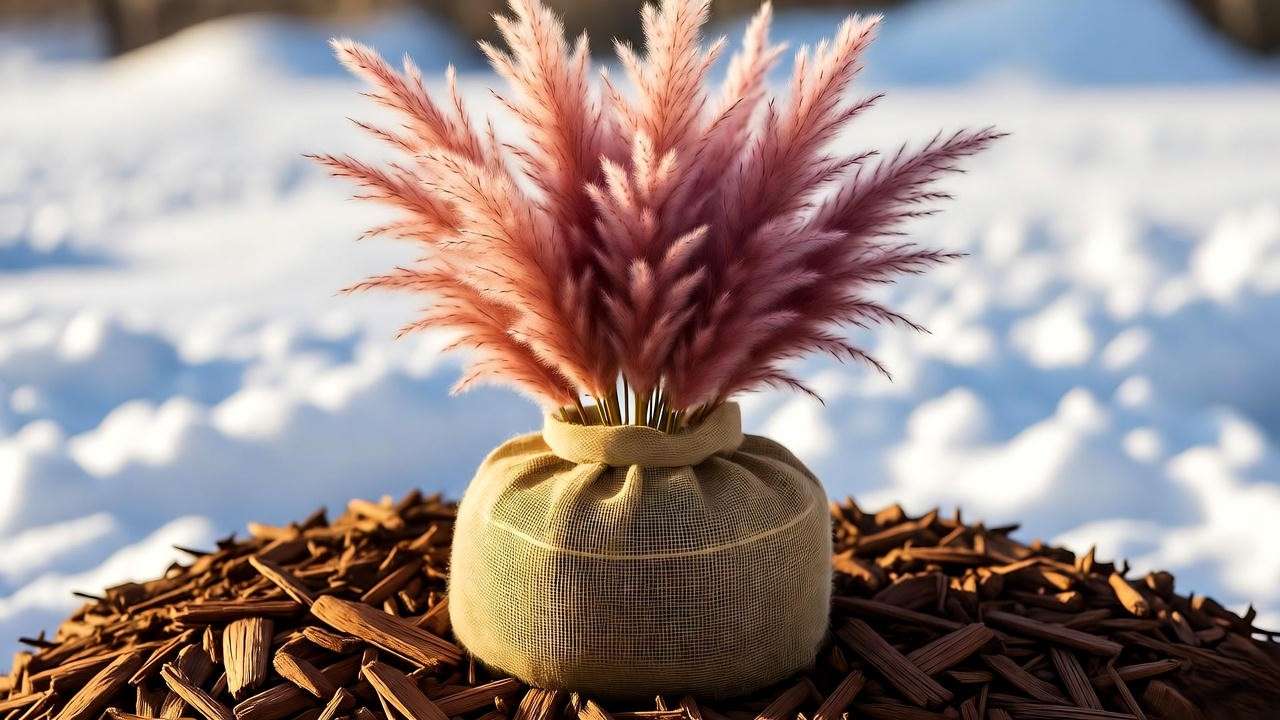
7. Expert Tips for Thriving Pink Pampas Grass 🌟
To ensure your pink pampas grass plants reach their full potential, consider these expert-backed strategies from horticulturists and seasoned gardeners:
- Optimize Soil Health: Before planting, test your soil’s pH and nutrient levels. Amend with compost or organic matter to improve drainage and fertility, as pink pampas grass thrives in nutrient-rich, well-draining soil.
- Use Eco-Friendly Practices: Opt for organic fertilizers like fish emulsion or compost tea to promote sustainable growth without harming the environment.
- Seasonal Checklist:
- Spring: Fertilize and prune to encourage new growth.
- Summer: Monitor for pests and water sparingly during dry spells.
- Fall: Harvest plumes for decor and prepare for winter.
- Winter: Mulch and protect in colder zones to ensure survival.
- Avoid Overcrowding: Plant with ample space to prevent competition for nutrients and reduce disease risk. A 6–8 foot spacing is ideal for mature clumps.
- Monitor Growth Patterns: If plumes are smaller than expected, check for shading from nearby trees or structures, as pink pampas grass needs full sun to produce its iconic pink feathers.
Expert Tip Box: Top 5 Mistakes to Avoid When Growing Pink Pampas Grass
- Planting in shade—always choose full sun.
- Overwatering mature plants, which leads to root rot.
- Skipping pruning, resulting in a messy appearance.
- Ignoring local invasiveness regulations.
- Planting too close together, causing stunted growth.
These tips, drawn from years of gardening experience, will help you cultivate vibrant, healthy pink pampas grass that enhances your landscape year-round. 🌾
8. Environmental and Ethical Considerations 🌍
While pink pampas grass plants are a stunning addition to any garden, they come with environmental responsibilities:
- Invasiveness Concerns: In regions like California, Australia, and parts of New Zealand, pampas grass is classified as an invasive species due to its ability to spread rapidly via wind-dispersed seeds. Check with your local agricultural extension office to ensure it’s safe to grow in your area.
- Control Measures: To prevent unwanted spread, remove plumes before they release seeds or opt for sterile cultivars if available. Growing in containers or using root barriers can also limit invasiveness.
- Sustainable Gardening: Choose eco-friendly practices, such as drip irrigation to conserve water and organic pest control to protect local ecosystems.
- Native Alternatives: If pink pampas grass is invasive in your region, consider native ornamental grasses like switchgrass (Panicum virgatum) or little bluestem (Schizachyrium scoparium) for similar aesthetic benefits with less environmental impact.
By gardening responsibly, you can enjoy the beauty of pink pampas grass while protecting your local ecosystem. 🌱
9. FAQs About Pink Pampas Grass Plants ❔
To address common reader questions and boost SEO, here are answers to frequently asked questions about pink pampas grass plants, grounded in expert knowledge:
Q1: How fast do pink pampas grass plants grow?
Pink pampas grass grows rapidly, reaching 6–10 feet in height within 2–3 years under optimal conditions. Plumes typically appear in the second or third growing season.
Q2: Are pink pampas grass plants safe for pets?
The sharp-edged leaves can cause cuts or irritation if pets chew or brush against them. Keep pets away from the plant, especially during pruning, and consult a veterinarian if ingestion occurs.
Q3: Can I grow pink pampas grass in containers?
Yes, but choose large containers (at least 15–20 gallons) to accommodate the extensive root system. Ensure excellent drainage and place in full sun. Container-grown plants may need more frequent watering.
Q4: How do I dry pink pampas grass plumes for decor?
Cut plumes in late summer when fully developed. Hang upside down in a dry, well-ventilated area for 2–3 weeks. Spray lightly with hairspray to prevent shedding and maintain their pink hue.
Q5: What’s the difference between pink and white pampas grass?
Pink pampas grass (Cortaderia selloana ‘Rosea’) has blush-pink plumes, while white pampas grass (Cortaderia selloana) features creamy-white plumes. Both share similar care requirements, but pink varieties add a warmer, more vibrant aesthetic.
These FAQs address searcher intent, providing quick, actionable answers to enhance user experience and encourage engagement. 🌸
10. Conclusion: Transform Your Garden with Pink Pampas Grass 🌺
Pink pampas grass plants are more than just a trendy garden addition—they’re a low-maintenance, visually stunning way to elevate your outdoor space. From their feathery pink plumes to their versatility in landscaping and decor, these ornamental grasses offer endless possibilities for creating a dreamy, Instagram-worthy garden. By following this guide’s expert tips on planting, care, and design, you can cultivate thriving pink pampas grass that becomes the centerpiece of your landscape. Whether you’re using it as a privacy screen, a focal point, or a chic decor element, this plant delivers beauty with minimal effort.
Ready to get started? Plant your pink pampas grass today and watch your garden transform into a vibrant oasis! Share your success stories, photos, or questions in the comments below—we’d love to hear how your pampas grass journey unfolds. For more gardening inspiration, explore our articles on ornamental grasses, drought-tolerant plants, or sustainable landscaping. Happy gardening! 🌿✨

